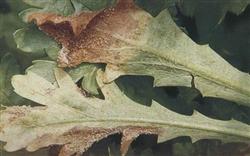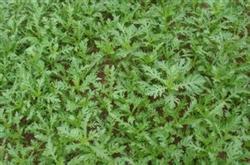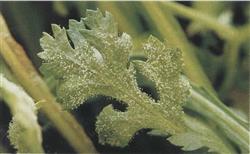Cultivation techniques of Artemisia annua in Solar greenhouse

1. Requirements for environmental conditions 1. Temperature chrysanthemum chrysanthemum is a semi-hardy vegetable, like cold, cool and mild climate, afraid of hot. The seeds germinated at 10 ℃, and the optimum temperature for growth was 17-20 ℃. Above 29 ℃, the leaves were small and few, and the texture was thick and old. Can withstand a short-term low temperature of about 0 ℃. two。 Artemisia annua L. is a long-day crop, which can tolerate weak light, and high temperature and long sunshine can cause bolting and flowering. Bolting is generally not easy to occur when cultivated in solar greenhouse in winter and spring. 3. Water chrysanthemum chrysanthemum is a shallow root vegetable with fast growth and small nutritional area per plant, which requires adequate water supply. The soil should always be kept moist. 4. Soil fertilizer is not very strict to the soil, but the fertile loam is the most suitable for the growth of Artemisia annua when its ph value is 5.5-6.8. Due to the short growth period and taking stems and leaves as commodities, it is necessary to apply available nitrogen fertilizer at the right time. 2. The varieties of Artemisia annua can be divided into two types: big leaf species and small leaf species. The big-leaf species has higher yield, but poor cold tolerance, which is mainly cultivated in the south. Small leaf species, also known as Artemisia annua, is not as good as Artemisia annua L., with strong cold resistance, short growth period and strong aroma, which is the main type in the north. (3) 2500-5000 kg of high-quality farm manure, 50-100 kg of calcium superphosphate and 50 kg of ammonium bicarbonate are used for land preparation and fertilization. Apply it to the ground, turn it over twice by hand, and mix the fertilizer and soil well. After holding flat to make a bed, the width of the border is 1 to 1.5 meters, and then hold flat and tread gently in the border to prevent sinking after watering. Fourth, the sowing amount is 1.52kg per mu. It can be divided into broadcast and strip broadcast. When sowing, trench is opened at a distance of 15-20 cm in the border, with a depth of 1 cm. Water is watered with a pot in the ditch, and the soil is covered with seeds after water infiltration. Fifth, post-broadcast management 1. Water and fertilizer management should keep the ground moist after sowing to facilitate seedling emergence. The seedlings were watered when the seedling was 3 cm high, and watered for 2 times during the whole growth period. Seedling height 9 cm 12 cm topdressing the first fertilizer, with the water mu of ammonium nitrate 10 kg 15 kg, a total of 2 times. two。 Temperature management after sowing, the temperature is slightly higher, sunny day 20: 25 ℃, night 10 ℃, 4-5 days or 6-7 days. After emergence, it can be 15: 20 ℃ in daytime and 8: 10 ℃ at night. Sixth, the harvest of chrysanthemum chrysanthemum is divided into one-time harvest and phased harvest. One-time harvest is 40-50 days after sowing, the seedling height is about 20 cm, close to the ground to harvest. There are two methods of harvesting by stages, one is to harvest thinly, the other is to keep 1 or 2 side branches, watering and fertilizing once after each harvest, and can be harvested again every 20 to 30 days. The yield is 1000-1500 kg per mu.
- Prev

Technical points of field management measures of Artemisia annua L.
The work of interseedling is done well, chrysanthemum not only has high yield, but also does not bend, and the quality is good. In addition to selecting seedlings with the same growth, we should also pay attention to the appropriate time between seedlings. If the seedlings are too early, it is easy to take secondary work, because the seeds sown into the ground will not grow at the same time, some seed seedlings have been unearthed, while others.
- Next

Comprehensive control of chrysanthemum downy mildew in autumn
The downy mildew of Artemisia annua is mainly harmful to leaves. At the initial stage of the disease, a light yellow nearly round or polygonal disease class was produced on the old leaves of the lower part of the plant, which gradually spread to the middle and upper part of the plant, and the disease class was yellowish brown in the later stage. When the humidity is high, there is a white mildew layer on the back of the class. Bacterial infection.
Related
- Where is it suitable to grow horseradish in China? it is expected to see the middle altitude horseradish in Alishan.
- How to prevent tomato virus disease reasonably? (Control methods included)
- Many people like to plant towel gourd on the balcony. What are the main points of this method and management?
- What crops can chili peppers be mixed with?
- Fertilization techniques and matters needing attention in Tomato
- What are the grafting techniques for peach seedlings in spring?
- Harm and control methods of root swelling disease of Chinese cabbage
- What are the pests of sweet potatoes? How to prevent and cure it?
- Symptoms, causes and Control methods of navel Rot in Tomato
- The cause of "Cucumber rotten bibcock" in Farmers' planting Cucumber and its Control Plan

